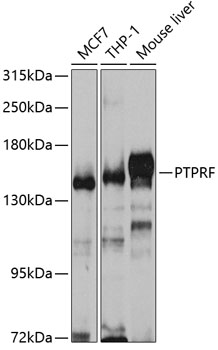Cell Biology Antibodies 9
Anti-PTPRF Antibody (CAB5444)
- SKU:
- CAB5444
- Product Type:
- Antibody
- Reactivity:
- Human
- Reactivity:
- Mouse
- Host Species:
- Rabbit
- Isotype:
- IgG
- Antibody Type:
- Polyclonal Antibody
- Research Area:
- Cell Biology
Description
| Antibody Name: | Anti-PTPRF Antibody |
| Antibody SKU: | CAB5444 |
| Antibody Size: | 20uL, 50uL, 100uL |
| Application: | WB |
| Reactivity: | Human, Mouse |
| Host Species: | Rabbit |
| Immunogen: | Recombinant fusion protein containing a sequence corresponding to amino acids 30-190 of human PTPRF (NP_569707.2). |
| Application: | WB |
| Recommended Dilution: | WB 1:500 - 1:2000 |
| Reactivity: | Human, Mouse |
| Positive Samples: | MCF7, THP-1, Mouse liver |
| Immunogen: | Recombinant fusion protein containing a sequence corresponding to amino acids 30-190 of human PTPRF (NP_569707.2). |
| Purification Method: | Affinity purification |
| Storage Buffer: | Store at -20'C. Avoid freeze / thaw cycles. Buffer: PBS with 0.02% sodium azide, 50% glycerol, pH7.3. |
| Isotype: | IgG |
| Sequence: | DSKP VFIK VPED QTGL SGGV ASFV CQAT GEPK PRIT WMKK GKKV SSQR FEVI EFDD GAGS VLRI QPLR VQRD EAIY ECTA TNSL GEIN TSAK LSVL EEEQ LPPG FPSI DMGP QLKV VEKA RTAT MLCA AGGN PDPE ISWF KDFL PVDP ATSN GRIK QLRS G |
| Gene ID: | 5792 |
| Uniprot: | P10586 |
| Cellular Location: | Membrane, Single-pass type I membrane protein |
| Calculated MW: | 211kDa/212kDa |
| Observed MW: | 150kDa |
| Synonyms: | PTPRF, BNAH2, LAR |
| Background: | The protein encoded by this gene is a member of the protein tyrosine phosphatase (PTP) family. PTPs are known to be signaling molecules that regulate a variety of cellular processes including cell growth, differentiation, mitotic cycle, and oncogenic transformation. This PTP possesses an extracellular region, a single transmembrane region, and two tandem intracytoplasmic catalytic domains, and thus represents a receptor-type PTP. The extracellular region contains three Ig-like domains, and nine non-Ig like domains similar to that of neural-cell adhesion molecule. This PTP was shown to function in the regulation of epithelial cell-cell contacts at adherents junctions, as well as in the control of beta-catenin signaling. An increased expression level of this protein was found in the insulin-responsive tissue of obese, insulin-resistant individuals, and may contribute to the pathogenesis of insulin resistance. Two alternatively spliced transcript variants of this gene, which encode distinct proteins, have been reported. |
| UniProt Protein Function: | PTPRF: Possible cell adhesion receptor. It possesses an intrinsic protein tyrosine phosphatase activity (PTPase). Belongs to the protein-tyrosine phosphatase family. Receptor class 2A subfamily. 2 isoforms of the human protein are produced by alternative splicing. |
| UniProt Protein Details: | Protein type:Motility/polarity/chemotaxis; Membrane protein, integral; EC 3.1.3.48; Receptor protein phosphatase, tyrosine Chromosomal Location of Human Ortholog: 1p34 Cellular Component: integral to plasma membrane Molecular Function:heparin binding; transmembrane receptor protein tyrosine phosphatase activity; protein complex binding; protein tyrosine phosphatase activity Biological Process: cell migration; cell adhesion; transmembrane receptor protein tyrosine phosphatase signaling pathway Disease: Breasts And/or Nipples, Aplasia Or Hypoplasia Of, 2 |
| NCBI Summary: | The protein encoded by this gene is a member of the protein tyrosine phosphatase (PTP) family. PTPs are known to be signaling molecules that regulate a variety of cellular processes including cell growth, differentiation, mitotic cycle, and oncogenic transformation. This PTP possesses an extracellular region, a single transmembrane region, and two tandem intracytoplasmic catalytic domains, and thus represents a receptor-type PTP. The extracellular region contains three Ig-like domains, and nine non-Ig like domains similar to that of neural-cell adhesion molecule. This PTP was shown to function in the regulation of epithelial cell-cell contacts at adherents junctions, as well as in the control of beta-catenin signaling. An increased expression level of this protein was found in the insulin-responsive tissue of obese, insulin-resistant individuals, and may contribute to the pathogenesis of insulin resistance. Two alternatively spliced transcript variants of this gene, which encode distinct proteins, have been reported. [provided by RefSeq, Jul 2008] |
| UniProt Code: | P10586 |
| NCBI GenInfo Identifier: | 226709091 |
| NCBI Gene ID: | 5792 |
| NCBI Accession: | P10586.2 |
| UniProt Secondary Accession: | P10586,Q5T021, Q5T022, Q5W9G2, Q86WS0, D3DPX6, D3DPX7 |
| UniProt Related Accession: | P10586 |
| Molecular Weight: | 1907 |
| NCBI Full Name: | Receptor-type tyrosine-protein phosphatase F |
| NCBI Synonym Full Names: | protein tyrosine phosphatase, receptor type, F |
| NCBI Official Symbol: | PTPRF |
| NCBI Official Synonym Symbols: | LAR; BNAH2 |
| NCBI Protein Information: | receptor-type tyrosine-protein phosphatase F; LCA-homolog; leukocyte common antigen related; leukocyte antigen-related (LAR) PTP receptor; leukocyte antigen-related tyrosine phosphatase; receptor-linked protein-tyrosine phosphatase LAR; protein tyrosine phosphatase, receptor type, F polypeptide |
| UniProt Protein Name: | Receptor-type tyrosine-protein phosphatase F |
| UniProt Synonym Protein Names: | Leukocyte common antigen related; LAR |
| Protein Family: | Receptor-type tyrosine-protein phosphatase |
| UniProt Gene Name: | PTPRF |
| UniProt Entry Name: | PTPRF_HUMAN |
View AllClose







